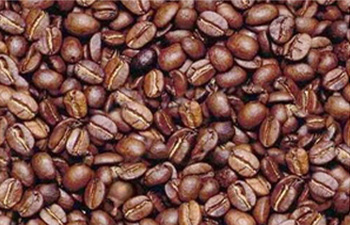Coffee Fact And Trivia

We have compiled a list of fun facts and trivia from around the world about coffee. We have facts like where coffee originated, how much coffee is consumed nationally and many more fun trivia facts. We hope you find these resources to be fun as well as educational, if you would like to add your coffee facts please contact us. While your here stop by and visit our very own locally roasted Catherine Marie’s Single Origin Coffees and use promo code “CMARIEXK10” to receive 10% off your coffee order.
Can you find the man in the coffee bean picture to the right -------------------------------------------------------------------------->
- Legends and myths state that a goat herder by the name of Kaldi found the first coffee forest in Ethiopia centuries ago and he reported the mysterious beans to the local monastery. Legend goes the monks made a beverage with the beans and felt energized, the new beverage started to spread worldwide by the 1700’s.
- Another legend about Kaldi the goat herder also states he stumbled upon the coffee when his goats ate the cherries and they were energized, Kaldi has now discovered coffee. In all honesty nobody really knows when or where coffee was first discovered.
- Coffee starts out as a yellow berry, change into a red berry and then is picked by hand to harvest. Through water soaking process the red berry is de-shelled and left inside is the green coffee bean. This bean then dries in the sun for 3-5 days where it is then packed and ready for sale.
- The most expensive coffee in the world is grown in Indonesia and referred to as Civet or Kopi Luwak coffee. The Asian Palm Civet a wild rodent eats the coffee cherries but can’t digest them. After the cherries have been fully digested farmers pick them up and sell the coffee beans for upwards of over $75.00 per pound.
- Single Origin Coffee: Coffee that is from a single estate, single farm, has 1 origin.
- There are two types of oils in coffee, good oils and bad oils. The good oils are good for your body and your health, the bad oils are what give you ulcers and stomach problems. To avoid the bad oils in coffee simply use paper filters to minimize the effects.
- Coffee starts out as a yellow berry, changes into a red berry and then is picked by hand to harvest. Through water soaking process the red berry is de-shelled and left inside is the green coffee bean. This bean then dries in the sun for 3-5 days where it is then packed and ready for sale.
- The average yield from one tree is the equivalent of one roasted pound of coffee.
- In 1824 Thomas Jefferson deemed coffee “The favorite drink of the civilized world”.
- Coffee is the second largest traded commodity in the world, oil is the largest.
- The Specialty Coffee Association of America (SCAA) estimates the specialty coffee revenue in 2006 at over $12.2 billion in sales. Over 75% of this business occurs in coffee cafes and coffee beverage retailers.
- According to a 2008 National Coffee Association (NCA) study, daily coffee consumption increased 3% in (2007) over the previous year (2006), while daily coffee consumption of any kind is down 2% for the same time. Gourmet coffee includes espresso-based drinks. The NCA poll surveyed more than 6000 adults over the Internet and by telephone in January and February of 2008.
- In Africa coffee beans are soaked in water mixed with spices and served as candy to chew.
- Brazil is the largest coffee producer in the world today producing over 44 million bags of coffee each year.
- The U.S. is the largest coffee consuming country in the world, estimating 400 million cups per day. (Hopefully not Styrofoam cups)
- There are 65 countries in the world that grow coffee and they are all along the equator.
- Mocha Java Coffee: One the largest misconception in the U.S. today about coffee is that Mocha Java coffee is a chocolaty beverage. In fact, there is no chocolate in the Mocha or Java bean at all. Mocha is the name of the largest port in Yemen, here is where all the African coffee beans are traded and transported. Java is the name of an island in Indonesia where the Java Bean comes from. Both coffees are a dark bean and provide a very rich and bold coffee, when you mix the two together you get Mocha Java coffee.
- Coffee in the United States is mainly only grown in California, Hawaii and Puerto Rico, although we have had a Kona coffee plant growing in Ohio for 20 years.
- In 1675 Charles II, King of England issued a proclamation banning Coffee Houses. He stated Coffee Houses were places where people met to plot against him.
- Black coffee with no additives contains no calories.
- There are two types of coffee plants, Arabica and Robusta, Arabica being the higher-grade coffee bean.
- An expert in brewing Turkish coffee is known as a "kahveci”.
- Robusta coffee beans have twice as much caffeine than Arabica beans, but are of less quality.
- A regular 8oz cup of coffee contains an average of 75-150 milligrams of caffeine, most physicians call this a "therapeutic dose”.
- There is no such coffee as decaffeinated coffee, decaffeinated coffee has about 50% less caffeine than regular coffee. The caffeine is removed by two different processes, solvent bases and non-solvent based.
- The darkest roasted coffee has the least amount of caffeine and the lightest roasted coffee has the highest amounts of caffeine. Simple science, the longer you roast coffee it gets darker and the caffeine evaporates. So if you really want that wake me up jolt go for the lightest roast you can find.
- Espresso Coffee has just one third of the caffeine content of a cup of regular coffee.
- James Mason invented the coffee percolator on December 26, 1865.
- Instant coffee was invented in 1901 by a Japanese American chemist known as Satori Kato. Later in 1906 a more known English chemist known as George Constant Washington claimed he invented instant coffee.
- On May 11, 1926, the slogan "Maxwell House Good to the last drop" was trademark registered.
- Melitta Bentz a housewife from Dresden, Germany, invented the first coffee filter in 1908.
- In 1822, the first espresso machine was made in France.
- In 1933, Dr. Ernest Illy invented the first automatic espresso machine.
- It takes five years for a coffee tree to reach full maturity, coffee trees can live up to 100 years old
- The custom of tipping waiters originated in early European Coffee Houses, to receive good service in that loud, dirty, hectic place you needed to Tip Big.
- In the 17th century when coffee came to Europe Pope Clement VIII banned coffee stating it was the "Devils Tool". This changed shortly after the Pope had a cup and pronounced coffee legal again.
- The term “Cowboy Coffee” originated from Cowboys using their dirty socks out on the trail as coffee filters. They filled there sock with coffee beans, immersed the sock in boiling water then squeezed the coffee into their cups.
- Both the American Revolution and the French Revolution were plotted in coffee houses.
- Dorothy Jones of Boston was the first American coffee trader, in 1670 she was granted a license to sell coffee.
- Coffee sacks are usually made of hemp and weigh approximately 132 pounds when they are full of green coffee beans. It takes over 600,000 beans to fill a coffee sack.
- There is no such bean as a Flavored bean, coffee is flavored with chemicals during the roasting process or like Catherine Marie’s coffee after roasting with natural and artificial flavored syrups and spices.
- The longer coffee beans soak in syrup flavoring the deeper the flavoring penetrates the bean, Catherine Marie’s flavored coffees soak for 3-7 days.
